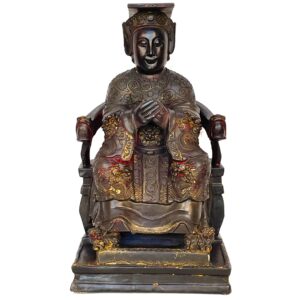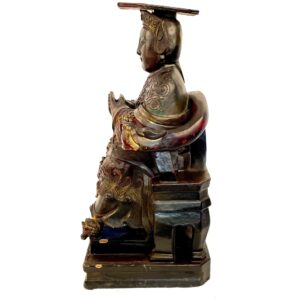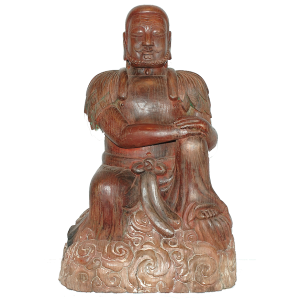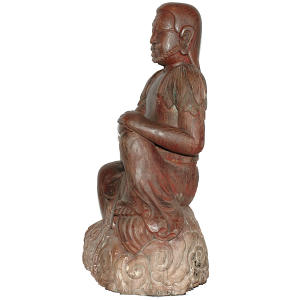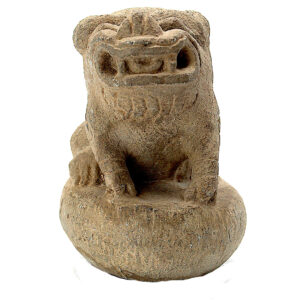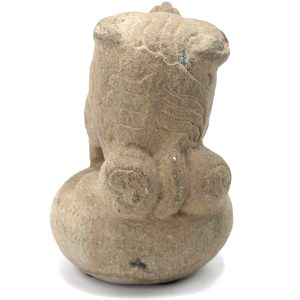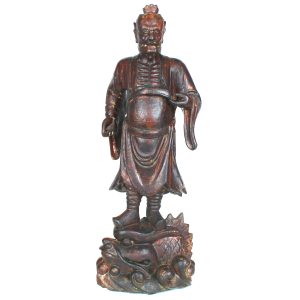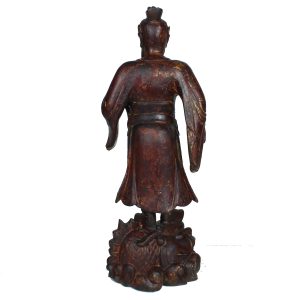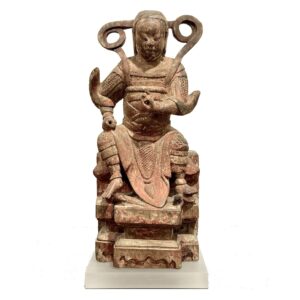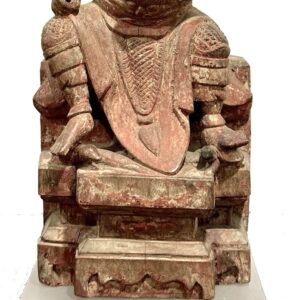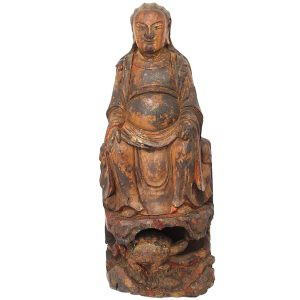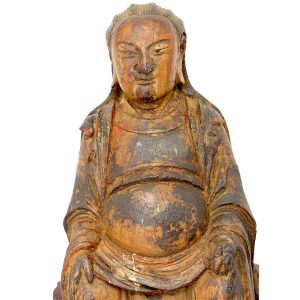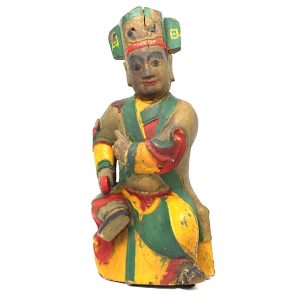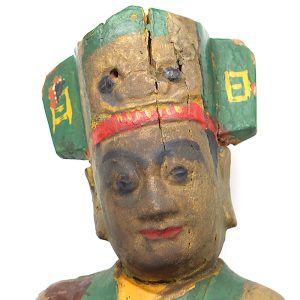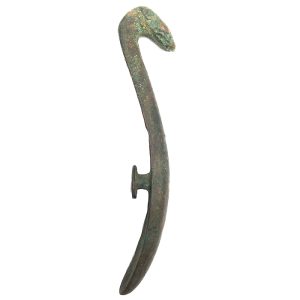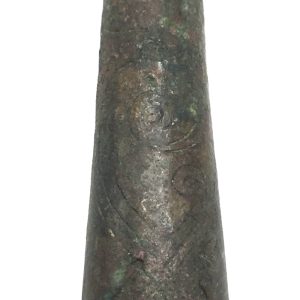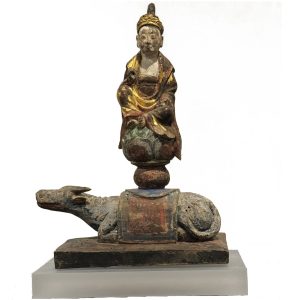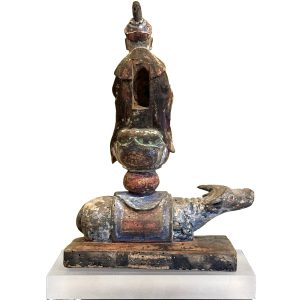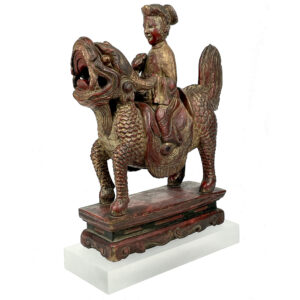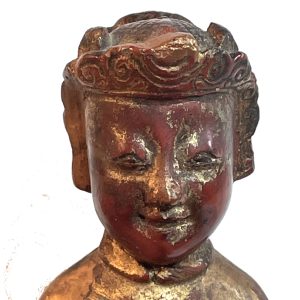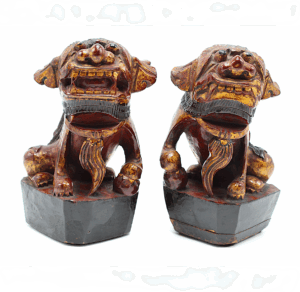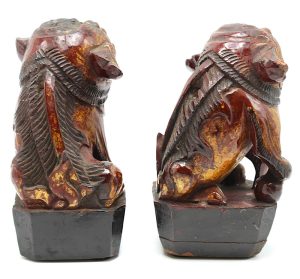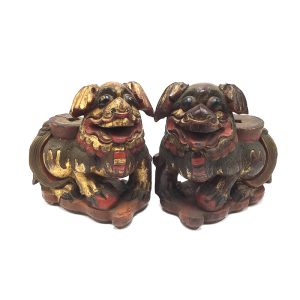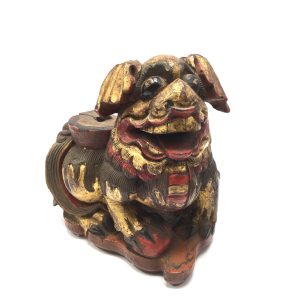Showing 13–24 of 32 results
-
Sale!


$1,050.00 Original price was: $1,050.00.$650.00Current price is: $650.00.
H: 15.375” W: 8.625” D: 7.5” | CONTACT US AT 213-568-3030 or email [email protected] for SHIPPING.
Mazu, protector of sea, is portrayed as the imperially sanctioned “Empress of Heaven” on an elaborate, horseshoe shaped dragon throne, holding a hu tablet, with elegant dragon robes, official’s girdle, Empress headdress and small feet on gilt fu lion foot rest.
-
Sale!


$4,600.00 Original price was: $4,600.00.$3,900.00Current price is: $3,900.00.
H: 30.5″ W: 19.25″ D: 11.75 | CALL 213-568-3030 OR EMAIL [email protected] FOR SHIPPING
Masterful carving of Shen Nong, revered hero and reputed father of both Natural Medicine and Agriculture. Benevolent, sitting on cloud, leaves on shoulders. One of 3 sovereigns who contributed to well-being of humanity. Especially fitting for health care, pharmaceutical or agricultural professional or associated with tea.
-
Sale!


$195.00 Original price was: $195.00.$155.00Current price is: $155.00.
H: 4.5″ Dia: 3.25″ | FREE SHIPPING WITHIN CONTINENTAL U.S.
This stone flu lion is not an elegant protective beast, it’s just a friendly pet hanging out. He probably lived in a garden and is looking for another one with people like old wonderful pieces to remind them not to take themselves too seriously.
-
Sale!


$1,095.00 Original price was: $1,095.00.$795.00Current price is: $795.00.
H: 15.5″ W: 5.5″ D: 4.5″| CALL 213-568-3030 OR EMAIL [email protected] FOR SHIPPING.
God of Literature, Books and Writing, Education, Learning and Examinations, Wen Chang is the patron saint of scholars. Thin, surly, demon like with exposed ribs and facial distortions, he stands on a dragon’ head among waves. Unique wonderful carving that would look spectacular on a desk.
-
Sale!


$1,250.00 Original price was: $1,250.00.$975.00Current price is: $975.00.
H: 15.25″ W: 6.75″ D: 6.75″ |CALL 213-568-3030 OR EMAIL [email protected] FOR SHIPPING
Zhenwu (Perfected Warrior) one of most important and powerful Taoist deities, is revered for magical powers to suppress demonic forces. Forceful wood provincial image for personal devotion reflecting his iconography: on throne, bare feet resting on snake and tortoise, celestial scarf and maille armor.
-
Sale!


$575.00 Original price was: $575.00.$495.00Current price is: $495.00.
H: 13″ W: 5″ D: 4.8″ | FREE SHIPPING WITHIN CONTINENTAL U.S.
Provincial carving of Zhenwu the Perfected Warrior, one of the most popular Taoist deities in the Ming/Qing dynasties, iconically shown standing on a snake and turtle, symbolizing those over whom he presides.
-
Sale!


$395.00 Original price was: $395.00.$295.00Current price is: $295.00.
H: 13.6 ” W: 7″ D: 5.5″ | FREE SHIPPING WITHIN CONTINENTAL U.S.
Taoist priest or shaman with a double-winged hat with a mythical taotie as a warning against greed and excess. His left hand in the Sword Gesture to cast out evil and right holding a tael symbolizing wealth and good fortune
-
Sale!


$485.00 Original price was: $485.00.$350.00Current price is: $350.00.
H: 4.1″ W: 1 ” D:.625 ” | FREE SHIPPING WITHIN CONTINENTAL U.S.!
In the Han, belt hooks became a symbol of wealth, high status and power hung vertically from belt holes used in life and buried with the deceased for his journey to the afterlife . Ornamented with incised decoration this beautiful piece is dragon shaped with beautiful verdigris deposits.
-
Sale!


$885.00 Original price was: $885.00.$725.00Current price is: $725.00.
H: 10.25″ W: 7.5″ D: 3.75″ | FREE SHIPPING WITHIN CONTINENTAL U.S.
Rare provincial carving of Guanyin on an ox reflecting the concept of bodhisattva reverence for “draft animals” (beasts of burden) who were integral to rural daily and agricultural activities in Chinese Popular Religion, Buddhism and Taoism.
-
Sale!


$895.00 Original price was: $895.00.$625.00Current price is: $625.00.
H: 9.5” W: 2.25” D: 6.5” | FREE SHIPPING within Continental U.S.!
This remarkable figurine is Guanyin on her mythical mount, the Hǒu, guardian master of the universe and model for righteousness and morality who symbolizes bringing forth peace and prosperity.The round orb in its mouth representing a pearl can be rubbed for good luck. It is one of our most unique and favorite Buddhist statues, mounted on a frosted Acrylic stand.
-
Sale!


$395.00 Original price was: $395.00.$350.00Current price is: $350.00.
H: 5.75″ W: 3.25″ D: 2.75″ | SOLD
Each of this whimsical gold and red-burgundy lacquered pair of male fu lions sits erect on a high pedestal heads thrown back with flaring ears, bulging eyes, decorative stylized manes and a small bushy tail. Their spirituality is displayed by the pair silently emitting the blessed mantra “aum”: the open mouthed lion forming an “au,” and the other completing it with a closed mouth to form “mmm.” The workmanship on these pieces is masterful, although rustic and provincial, and they are rare with their Buddhist symbolism and because most pairs of fu lions pairs were lost during China’s modernization.
-


$595.00
Whimsical carvings of fu lions were the most popular mythical animals in Chinese homes, especially during the Ming and Qing dynasties, as free standing statues, designs on furniture, architectural elements and functional pieces in private homes or gardens or on a home altar to bring fu and the blessings to the home. This incredibly cute…
End of content
End of content

